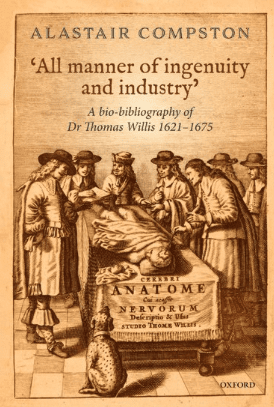Arpan K. Banerjee
Solihull, United Kingdom

Cover of “All manner of ingenuity and industry” by Alastair Compston.
Thomas Willis, born four hundred years ago, is still known by students of neuroanatomy today for the eponymous Circle of Willis. Yet most doctors do not know the story of Willis, the seventeenth-century British physician and his remarkable contributions to medical knowledge and literature.
This new book, a labor of love by Alastair Compston, the distinguished British neurologist and medical historian, is a biobibliography of Thomas Willis. In addition to providing an excellent biographical introduction of Willis, it also contains annotated illustrated volumes of his treatises and published works with an accompanying analysis of his contributions to medicine.
Willis was born in 1621 and studied medicine at Christ Church College, Oxford, at a time of political unrest during the Civil War in Britain. His Royalist support during this time of political upheaval resulted in a shorter-than-usual training time to obtain his medical license, which he obtained in 1646. He acquired a remarkable group of friends who were interested in science, including John Locke, Robert Boyle, Robert Hooke, and Christopher Wren, amongst others. He had a very busy private practice in the Oxford area and later in London and was considered one of the richest physicians in the UK by his contemporaries.
He was interested in anatomy and dissection, which would have been unusual for a physician in that era. He was helped in his endeavors by his student Richard Lower, John Locke, and Christopher Wren, a polymath who was also a brilliant mathematician and architect, today best remembered for designing St. Paul’s Cathedral in London.
Dissections enabled him to hone his knowledge of anatomy and do original research on the brain and cranial nerves (which he numbered, a system still used today), and resulted in his famous book written in Latin, the 1664 Cerebri anatome, where he described the arteries in the brain that comprise the Circle of Willis, as it is now known. In this book he first coined the term neurology. Christopher Wren provided some of the illustrations on engraved plates.
In the 1667 Pathologiae cerebri, his major work on neuropathology, he discussed the causes of epilepsy and laid the foundations for early psychiatry. In his book Two discourses on the soul of brutes, he expands on his interest in the philosophy of mind and neuropsychiatry. This work is considered to be one of the earliest books on psychology.
Willis even made contributions to diabetes and introduced the term “mellitus” in a chapter in his 1674 book Pharmaceutice Rationalis.
Willis was appointed to the chair of Natural Philosophy at Oxford in 1660 and was one of the early founding Fellows of the Royal Society of London. His writings were read in Europe, and after his premature death at fifty-four in 1675, his works were translated into English and appeared in 1684 as Dr. Willis’s Practice of Physick.
This book is a superb work of scholarship and allows the reader to marvel at Willis’s early contributions to medicine. The biographical sections are detailed and informative, the bibliography of work is encyclopedic in scope, and the accompanying analysis provides an excellent commentary and analysis of Willis’s achievements. The references are detailed in the accompanying footnotes and will allow future researchers more source material for reading. The author has produced an outstanding scholarly contribution to the medical history literature.
“All manner of ingenuity and industry”: a bio-bibliography of Dr. Thomas Willis 1621–1675
Alastair Compston, 2021
OUP 9780198795391
ARPAN K. BANERJEE, MBBS (LOND), FRCP, FRCR, FBIR, qualified in medicine at St. Thomas’s Hospital Medical School, London. He was a consultant radiologist in Birmingham from 1995–2019. He served on the scientific committee of the Royal College of Radiologists 2012–2016. He was Chairman of the British Society for the History of Radiology from 2012–2017. He is Chairman of ISHRAD and adviser to Radiopaedia. He is the author/co-author of numerous papers and articles on a variety of clinical medical, radiological, and medical historical topics and seven books, including Classic Papers in Modern Diagnostic Radiology (2005) and The History of Radiology (OUP 2013).
Highlighted in Frontispiece Volume 13, Issue 4 – Fall 2021

Leave a Reply